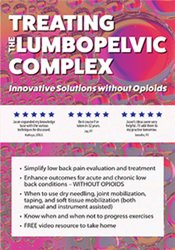Jason Handschumacher – Treating the Lumbopelvic Complex, Innovative Solutions without Opioids
$200 Original price was: $200.$75Current price is: $75.
Shopping Instructions:
- DISCOUNT 15% : SHOP15
- Product Delivery: Within 1 – 12 hours after purchase.
Simplify the lumbopelvic complex by learning a step-by-step approach to finding the cause and specific interventions that attack the cause at its root.
Jason Handschumacher – Treating the Lumbopelvic Complex, Innovative Solutions without Opioids
Low back pain – these three words used to evoke a myriad of responses in how I treated my patients. Prescriptions have long been an answer for pain reduction but now we must question such methods. Is exercise purely the answer? Where does manual therapy fit into the exercise regimen? And what about other treatment methods – IATSM, dry needling, and taping?
Simplify the lumbopelvic complex by learning a step-by-step approach to finding the cause and specific interventions that attack the cause at its root. I will show you simple and effective manual therapy treatments including joint mobilization, soft tissue mobilization (both manual and instrument assisted), dry needling, and taping all geared to help your patients return to function and reduce pain. I’ll also share how to skillfully apply pain science education and how your specific language choices can help break through fears and misconceptions surrounding pain.
- Review relevant anatomical structures and stability concepts
- Discuss the efficient and reliable clinical examination and interpretation of findings to guide successful treatment
- Demonstrate the proper measrement and documentation protocol for clinical examination of a patient presenting with lumbopelvic issues
- Examine the current literature regarding lumbopelvic clinical examination findings, joint mobilization, non-surgical stabilization options, and exercise
- Create a plan that implements pain science research and education for the patient in front of you
- Demonstrate effective manual therapy and therapeutic exercise interventions to treat the lumbopelvic complex
Would you like to receive Jason Handschumacher – Treating the Lumbopelvic Complex, Innovative Solutions without Opioids ?
LUMBOPELVIC ANATOMY AND STABILITY CONCEPTS
- Interrelation of the lumbar spine, pelvis, and hips
- Form closure, force closure, and Tensegrity stability concepts
- Spinal engine/ myofascial slings
CLINICAL EXAMINATION – CREATING THE ULTIMATE LIST
- Step-by-step measurement and documentation
- Incorporating imaging studies: when they matter and when they don’t
- Normal values and when they matter
- Interpreting clusters of signs and symptoms
- Dynamic motion and stability testing
- Assess and interpret neural mobility testing
- Differentiating lumbar, pelvic, and hip symptoms
- Using current Clinical Practice Guidelines
BEST INTERVENTIONS FROM EXAMINATION
- Know which findings contribute to symptoms
- Is the issue mobility, stability, both, or something else?
- How manual therapy can improve muscular activity and enhance exercises
- Train dynamic movements, not just muscles
- IASTM, dry needing, and taping – when they help and when they don’t
- Improve carryover after discharge
INCORPORATING PAIN SCIENCE EDUCATION
- Simplify neuroscience into understandable terms
- Pain is normal, chronic pain is not
- “Hurt vs. harm” and graded exposure to activity concepts
- Empower people over pain
- Use of video and printed materials specific to patients
PUTTING IT ALL TOGETHER – LAB PRACTICE AND DEMO
- Reliable measurements with simple equipment
- Manual therapy for even novice clinicians
- When and when not to progress exercises
- Video and live demonstrations
Related products
NLP & Hypnosis
NLP & Hypnosis
NLP & Hypnosis
NLP & Hypnosis
NLP & Hypnosis
NLP & Hypnosis
NLP & Hypnosis












